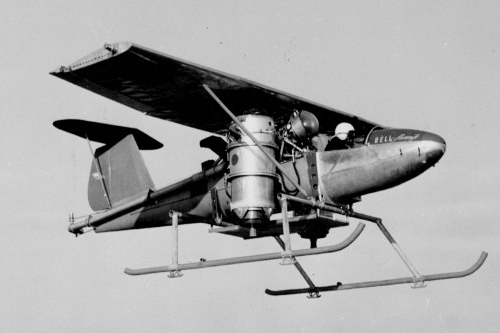

Le Bell model 65 Air Test Vehicule (ATV) était un projet expérimental d’avion à décollage vertical utilisant deux turboréacteurs à la fois pour le vol vertical et le vol horizontal.
Il s’agissait de 2 Fairchild J44, chacun d’eux ayant une puissance de 454 kg de poussée. Ils étaient montés de part et d’autre, le long du fuselage, et pouvaient pivoter de 90°, depuis la position vertical jusqu’à l’horizontal.
This VTOL was a private-venture test vehicule (Bell Chief Aircraft Engineer, Stan Smith, obtained $100,000 of Bell funds Apr 53 to develop ATV) which had been built up from a number of readily available components :
- Schweizer 1-23 sailplane fuselage and empennage,
- Cessna 170 wing,
- Bell 47 landing gear,
- French Turbomeca Palouste turbocompressor for vertical flight reaction thrust via ducts and nozzles in wing tips and tail.
- Fairchild J44 turbojet engines supplied by Air Force ( 6 with 5-hr service life for $1 each).
First flights of N1105V culminated Jun 54 with compressor failure on right engine which severed fuel line and destroyed tail while Joe Cannon was testing it.
Repaired, was successfully flown by Dave Howe 16 Nov 1954 and partial transitions to horizontal flight performed with engines left in vertical position.
Apr 55, conventional Cessna landing gear installed, and vertical and horizontal flights were made by Howe.

In May, Howe unsuccessfully attempted horizontal to vertical transitions at 5,000 feet; when engines rotated, pitch-up occurred, and as stick was pushed forward to compensate, aerodynamic and reaction control pressures were sufficient to deform aft fuselage.
Since major test aims were complete and last J44s had 4.5 hours on them, project was terminated in favor of X-14.
ATV weighed about 2,000 pounds and accelerated from 0-100 mph in 100 ft.
Was only able to fly well in cold weather (relatively high air density) when engine thrust was about equal to aircraft weight.
6 key test results:
- successful turbojet VTOL flight with a 1:1 power/ weight ratio;
- proof that a person could control such an aircraft;
- simple, workable reaction control system;
- jet engines operating in sustained vertical and horizontal positions;
- transitional flight that was more stable than hovering flight;
- proof that jets could be operated vertically over concrete surfaces without damaging them.


Comments
First jet V/STOLL flown in U.S. No stability augmentation was required. Engines rotated on a common shaft through the fuselage. Each reaction control system (RCS) nozzle was mechanically linked to the corresponding aerodynamic control surface. Partial transitions were accomplished at 30 to 40 ft. altitudes. No complete transitions were performed. Engines were not manrated and limited to 5 hours
Go – Ahead Mar 1953
First hover Nov 1954
Last flight Mar 1955
Source : DTIC ADA089492: Application of Powered High Lift Systems to STOL Aircraft Design. by Defense Technical Information Center. Publication date 1979-09-01
Its first flight was made in January 1954 on a tether. The ATV was damaged the next month from an engine failure and subsequent fire. After repairs, flight tests resumed, but the program was terminated in early 1955 after only 4.5 flight hours. The ATV was to be followed by the successful X-14 or Model 68

